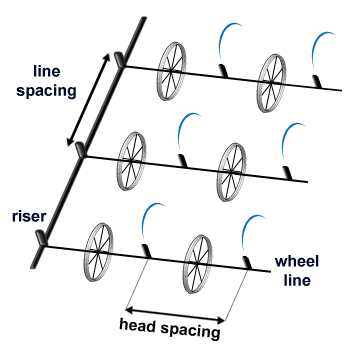Set Move Sprinklers
Use this form to calculate recommended set times, nozzle diameters, pipe sizes, and lateral pressure losses for hand move, or wheel line sprinklers where a line of sprinklers irrigates in a stationary position and then moved every day or so. This will help you come up with a suggested move interval (12, or 24 hr sets) and a suggested sprinkler nozzle size. Learn more about the units used on this page.
Net Depth, Suggested Move Interval, and Suggested Nozzle Diameter
A soil's water holding capacity is the difference between field capacity and wilting point. For more information about a particular area, check the Columbia Basin Soil Survey or get suggested capacities by soil or by crop type.
The maximum net depth of water per irrigation is defined by how much water a soil can hold without losing it to leaching. If the soil is full of water, the crop can use this much water before it starts to be stressed. The move interval assumes a maximum set time on only 12 hour intervals to make moving sets manageable. A good estimate for a set-move sprinkler ranges from 50 - 75%. The suggested nozzle diameter assumes that the nozzles are in good condition, and are all the same (replacement nozzles are typically less than $1 per nozzle).
